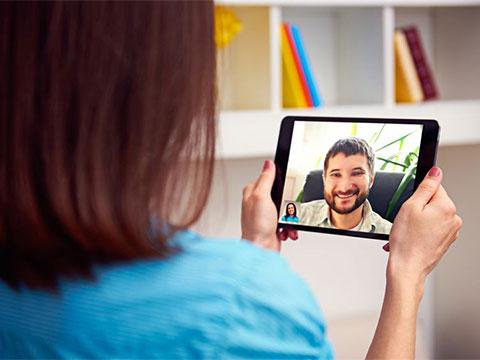Therapy without the Office
- By Mark Saltveit
- Reading Time: 4 mins.
 The need to connect patients with faraway doctors used to be a hallmark of only the most remote jobs—astronauts and researchers at the Antarctic research station, for instance. Telemedicine arose naturally out of the combination of irreplaceable, highly skilled staff and the inability to physically access traditional doctors.
The need to connect patients with faraway doctors used to be a hallmark of only the most remote jobs—astronauts and researchers at the Antarctic research station, for instance. Telemedicine arose naturally out of the combination of irreplaceable, highly skilled staff and the inability to physically access traditional doctors.
And while your best programmer or salesperson may not be as impossible to replace as an astronaut in space, their absence is certainly felt, even for a few hours. Add in travel time to the other side of Manhattan during rush hour or a drive across Wyoming to see a specialist (which could take longer than a space shuttle flight to the International Space Station), and it’s easy to see why telemedicine continues to gain currency in today’s benefits landscape.
When you say “telemedicine,” most people think of virtual appointments—basically, a standard doctor visit that takes place over video rather than in person. But this rapidly growing field is much larger and more varied than that: for the most part, X-rays are now recorded digitally rather than on film, meaning that technicians can analyze the results from anywhere on earth. Patients can monitor their blood sugar or blood pressure at home and send results to their M.D. And several companies are developing sensor technology that monitors whether patients are actually taking prescribed drugs.
The Kaiser Permanente health system is perhaps the leading adopter of distance technologies in various settings, from group visits for new mothers to on-site workplace clinics staffed via video. The emerging model isn’t replacing live doctors with some distant provider; instead, it’s creating a hybrid that uses telemedicine for initial contact and for highly specialized referrals to care that isn’t available locally.
Get tips for your office
Be an office hero!Therapy on the Go
One of the most successful applications of distance technology may surprise you: mental health treatment. Kaiser is one of several insurers that allows patients to visit psychologists, therapists, and psychiatrists remotely.
The FruitGuys Magazine spoke with two tele-psychologists to discuss this development. Dr. Nicole Washington, D.O., is a psychiatry specialist in Tulsa, OK, who sees a number of clients via tele-therapy, and Sarah Gray, Psy.D., is a clinical psychologist and an instructor at Harvard Medical School.
There are several advantages to using tele-therapy, starting with time and convenience. For workplaces, it’s as if you’ve hired an on-site therapist. Telepsych appointments take up only the time of the actual appointment, eliminating travel time and related delays.
The flexibility afforded by tele-therapy can also help those who can’t use their work hours for a therapy session. Remote therapists who work from the comfort of their own homes are more likely to offer hours outside of the standard workday. Washington, who goes by “Dr. Nicole,” told us that “my target professionals are [in] high-level professions, people who keep long hours and might be more willing to engage in treatment if they can do it at six or seven o’clock in the evening.”
 Limitations to Consider
Limitations to Consider
Dr. Gray notes two particular groups of people who are especially suited to tele-visits: staff who work from home, and those with social phobia or agoraphobia, who can find it difficult to get to a therapist’s office in the first place.
There are some limitations. You can’t literally phone it in—only video appointments are reimbursed by insurance, and some states require an initial in-person session before any telepsych meetings take place. And you can’t just Skype or FaceTime your therapists; privacy regulations require HIPAA-approved therapy software. Generally, it’s up to the therapist to get approved video software, but you (and your IT department) may need to double-check that everything is in order.
Even with HIPAA-approved software and a good video connection, therapists may not get quite as much information as they would during an in-person appointment. Does the patient have alcohol on their breath or smell like they’ve stopped bathing? Dr. Gray observes that “the screen doesn’t usually show the full body, so I don’t get the full body language information. Also, the quality is dependent on internet quality connections, both mine and the patient’s.”
Licensing is also an issue. Telemedicine providers are licensed on a state-by-state basis, which might make it difficult for companies that have offices in many different states. The good news is that many of these details will be handled by your insurance provider or Employee Assistance (EAP) plan.
For many people, there are a lot of hurdles to initiating mental health treatment, from stigma to provider scarcity. Innovations like remote therapy appointments help make it easier to access care—and employers who want a mentally healthy workforce should support these advances. HR folks should check to see whether their current insurance plans offer tele-therapy coverage. If they do, spread the word so your staff is aware of this valuable benefit.
Want farm-fresh fruit?
We've got you covered.Mark Saltveit is the author of The Tao of Chip Kelly (Diversion Books: 2013) and the upcoming Controlled Chaos: Chip Kelly’s Football Revolution (Diversion Books: 2015). He writes regularly about health and science for the Oregon Bioscience Association, and about football for Philly.com, BleedingGreenNation.com, IgglesBlitz, and FishDuck.com. His work has also appeared in Harvard Magazine and The Oregonian newspaper.


